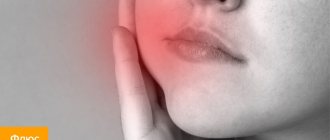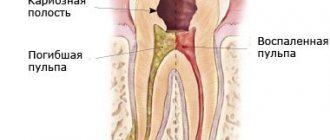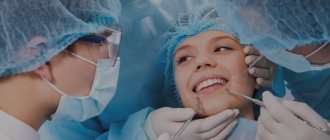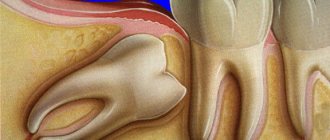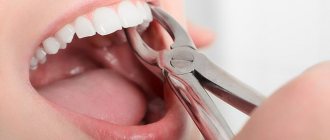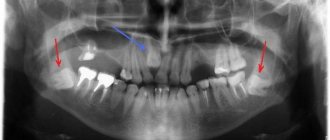From this article you will learn:
- symptoms of wisdom tooth growth,
- what to do if your wisdom tooth is cutting out and your gums are swollen or you have a fever.
The article was written by a dental surgeon with more than 19 years of experience.
The wisdom tooth is located at the very end of the dentition, and therefore it is often called the “figure eight” (the serial numbers of the teeth are assigned starting from the central incisors). Thus, a person has only 4 wisdom teeth - one on each side of the upper and lower jaw. No other teeth cause us so much discomfort and pain when they begin to erupt. It most often occurs between the ages of 18 and 21, but can occur at 14 or 40 years of age.
It is interesting that the incidence of difficult wisdom teeth eruption increases with each generation. This is due to the chewing load, and the fact that people are increasingly eating too soft, overly processed food. As a result, the chewing load that the teeth transmit to the bone tissue of the jaws turns out to be insufficient, which leads to a gradual decrease in the mass and volume of the bone, including a decrease in the length of the lower jaw. As a result, with the same number of teeth, we have less and less space for their eruption.
How a wisdom tooth is cut: photo, x-ray
As a result, competition arises between teeth for a place in the dentition, and those teeth that erupt last are in the most disadvantageous position. Most people are familiar with the fact that when a wisdom tooth is cut, the symptoms of eruption and associated inflammation can cause a lot of inconvenience. And this is not only pain, suppuration or just felt discomfort. If there is not enough space in the dentition, the erupting wisdom teeth put pressure on the teeth in front, moving them to the center of the dentition. It is for this reason that many patients experience crowding of their front teeth over time.
A few facts about wisdom teeth –
Wisdom teeth are the only teeth in which the formation of germs does not occur during intrauterine development, but already in a born child at the age of 4-5 years.
In this case, the crown part of the wisdom tooth completes its formation at the age of 12 years, and the end of the formation of the roots usually occurs no earlier than 24 years. On the x-ray you can see a wisdom tooth whose roots have not yet completed formation (compare with the roots of the 7th tooth in front). Well, the last feature that we talked about above is that the eruption of all other teeth in the permanent dentition occurs in the period from 6 to 13 years, and only the eighth teeth usually begin to erupt no earlier than 18-21 years.
Eruption of wisdom teeth: symptoms
The duration of symptoms of the eruption of a wisdom tooth will depend on the availability of sufficient space in the dentition for its eruption, as well as on the position of the tooth in the jaw. If there is not enough space for eruption, it can only partially erupt (for example, by one or several cusps of the crown part of the tooth). The tooth can remain in this state for many years and decades - until it moves the tooth in front and makes room for itself.
All this time, you may feel periodic discomfort, especially pronounced during periods of colds. Also, the cause of difficult eruption may be the incorrect orientation of the tooth in the jaw, for example, it may begin to erupt at a strong angle to the 7th tooth in front (resting against it with the cusps of the crown part). Unfortunately, this process will be accompanied not only by negative symptoms of teething, but will also lead to the gradual destruction of the crown of the 7th tooth.
Destruction of the crown of the 7th tooth during the eruption of a wisdom tooth –
Eighth teeth that have difficulty erupting (due to horizontal position or lack of space in the dentition) are usually called impacted. Dentists most often recommend removing such teeth to prevent displacement and crowding of the front teeth, or damage to the teeth in front. You can read more about the indications for deletion/saving at the link below.
→ Indications for wisdom teeth removal
The main symptoms of teething are:
Traditionally, we will start with the most unpleasant symptoms that patients have to face. They arise as a result of the development of inflammation of the gums over a partially erupted wisdom tooth. Depending on the severity of the inflammation, only swelling and redness of the gums may be observed, or they may also be accompanied by suppuration and swelling of the soft tissues of the face (24stoma.ru).
- Swelling of the gum or cheek near the wisdom tooth – swelling of the gums around a wisdom tooth usually occurs as a result of the formation of a “hood” over it. The latter is a section of the gum mucosa that hangs over the crown of the wisdom tooth (Fig. 2). Such a hood is formed when a tooth partially erupts, and dentists call its inflammation the term “pericoronitis.” Inflammation occurs because food debris and plaque accumulate between the hood and the chewing surface of the tooth, i.e. good conditions are created for the growth of bacteria.
If you have an inflammation of the hood - 1) it is necessary to determine the feasibility of saving the tooth, 2) if there are no indications for removal, the hood must be excised, as well as anti-inflammatory treatment prescribed (see below), 3) but if there is not enough space in the dentition, excision of the hood will not solve the problem completely, because After some period of time, the gums will again partially cover the crown of the wisdom tooth, and new inflammation will develop.Important : if your gums are swollen, your wisdom tooth needs to be shown to the dentist urgently. Although with minor inflammation (only swelling and redness of the hood, without suppuration), in some cases you can cope with home remedies, which we wrote about at the end of the article. If you see that pus is oozing from under the hood, or it appears when you press the hood, you need to urgently run to a dental surgeon. In some cases, suppuration of the hood of a wisdom tooth ends with the development of phlegmon of the floor of the mouth or submandibular space.
The same applies to the situation when a wisdom tooth is cut - the cheek is swollen, and not just the gums. This also indicates the development of purulent inflammation and its spread towards the soft tissues of the cheek. In all of the above situations, you cannot self-medicate, postponing a visit to a dental surgeon, because In most cases, no antiseptic rinses or antibiotics help.
- Difficulty opening the mouth is an unfavorable symptom that indicates the progression of purulent inflammation and its transition from the hood above the wisdom tooth to the masticatory muscle. If you don’t immediately consult a dentist, your mouth will open less and less (until it closes completely). As soon as this happens, it will be possible to help the patient only in a hospital setting.
- Painful swallowing is also an extremely unfavorable symptom, which indicates the spread of purulent inflammation towards the pharynx and floor of the mouth. This is a very dangerous place for localization of inflammation, because all this can result in abscesses and phlegmon of the peripharyngeal space, as well as the area of the floor of the mouth. If this happens, you will remember the experiences you receive in the hospital for the rest of your life.
- Temperature during the eruption of wisdom teeth - if a wisdom tooth is being cut - a temperature of up to 37.5 may periodically appear even without suppuration of the hood. In general, the temperature will directly depend on the severity of inflammation, and if suppuration does occur, the temperature may be higher. A slight fever and slight discomfort in the area of the erupting wisdom tooth often appear during periods of decreased immunity, hypothermia, and against the background of colds.
- Painful sensations –
pain is characteristic of any inflammatory process, including inflammation of the hood.
As inflammation develops, pain increases. However, in some cases, a sudden cessation of pain may not be due to the cessation of inflammation, but to the fact that the pus has come out of the confined space, but not out, but into the surrounding tissues. Also, pain during the eruption of wisdom teeth may be associated with a lack of space for eruption. In this case, the erupting wisdom tooth begins to make room for itself in the dentition due to the displacement of the remaining teeth. Those. it puts pressure on the seventh tooth in front, which in turn presses on the sixth molar, etc. That is, teeth shift (almost like during orthodontic intervention). Such tooth movements can also be accompanied by pain.
Pericoronitis and laser excision of the hood: video 1-2
Causes of swelling
Even standard surgery is not an easy process, and swelling in such cases is a common consequence. They appear for various reasons. Often the tumor goes away on its own, but sometimes the patient needs to see a dentist. Main provoking factors:
- Infection of the wound and the appearance of pus. Antiseptics are used for therapy. The inflammatory process can develop due to improper hygiene.
- When a patient is diagnosed with a dystopic tooth, adjacent units may be affected. Such pathologies cause swelling.
- If an abscess with pus has formed, the gum tissue is cut to ensure the drainage of exudate. As a rule, swelling in such situations is small and goes away on its own.
- The operation becomes more complicated if the patient has impacted rudiments, since their removal requires opening the mucosa. Such an intervention is easier to tolerate on the upper jaw, since its tissue is less dense.
- Irregular shape of the chewing organ, twisted roots, location in a place where it is difficult to reach - all this complicates the surgical process. Consequences are anomalous phenomena.
- When the cheek became swollen after the removal of a wisdom tooth in the lower jaw, the patient could have advanced caries, periodontitis, osteomyelitis, or a cyst in the root zone. Permanent soft tissue injury could develop from tilting the unit.
- The presence of hypertension, diabetes, and blood diseases in patients.
Help with home remedies -
As we said above, only with minor discomfort and inflammation can you cope with the situation with home remedies. It is better to use analgesics from the NSAID group (non-steroidal anti-inflammatory drugs) as an anesthetic. These drugs (for example, based on ibuprofen) have not only analgesic, but also a pronounced anti-inflammatory effect. If there are symptoms of inflammation of the hood above the wisdom tooth, it is necessary to use antiseptic rinses and anti-inflammatory gel applications.
- Chlorhexidine solution 0.5% - rinse 2-3 times a day for 1 minute, the solution is sold at the pharmacy ready to use. Immediately after rinsing, blot the gum above the wisdom tooth with a dry gauze swab and apply anti-inflammatory gel (it adheres better to dry mucous membranes).
- Applications of Cholisal gel are carried out 2-3 times a day, immediately after antiseptic rinsing. The gel is applied with light massaging movements to the hood area, then apply another portion of the gel to the hood without rubbing it. After application, it is not advisable to eat or rinse your mouth for 2-3 hours (you can drink). By the way, this gel not only relieves inflammation, but also has an analgesic effect.
However, keep in mind that if you have swelling of the cheek, difficulty opening your mouth, painful swallowing, suppuration from under the hood, swelling and pain in the submandibular area, you cannot self-medicate and should urgently consult a doctor. We hope that our article on the topic: How wisdom teeth are cut was useful to you!
Sources:
1. Higher prof. the author's education in surgical dentistry, 2. Based on personal experience as a dental surgeon, 3. National Library of Medicine (USA), 4. “Pathology of wisdom teeth eruption” (Rudenko A.), 5. “Qualified removal of third molars” ( Asanami S.).
Recommendations for pain relief
Not everyone has the opportunity to visit a dentist immediately when painful symptoms or discomfort appear. Can I relieve pain on my own? How to soothe the mucous membrane, reduce inflammation and bleeding? Before going to the dentist, you have at your disposal traditional medicine recipes:
- Soda solution. Effectively copes with swelling and pathogenic bacteria, prevents infection. used as a rinse.
- A decoction of oak bark and sage. We prepare a complex medicinal product as follows: take 5 tablespoons of each component, add 0.5 liters of boiling water. Let's give it time to brew. Use warm, rinsing your mouth at least 7-8 times a day. The product heals damage, reduces inflammation, and kills pathogenic microflora.
- Turnip decoction. Pour 200 ml of water into chopped root vegetables (3 tablespoons) and boil. Cook over low heat for 15 minutes. Used for rinsing once an hour.
- Saline solution. Dissolve 1 teaspoon of salt in a glass of water. Used for rinsing, without restrictions. It relieves swelling and inflammation well.
- Sea buckthorn oil. This valuable oil is used for applications on mucosal erosions. Quickly restores tissue structure and has regenerative properties.
- Melissa infusion. Take 2 tbsp. spoons of raw materials, add 0.5 liters of boiling water. Wrap the container with the preparation well and let it brew for 4 hours. Recommended for rinsing, up to 4 times a day.
- Chicory root infusion. Prepared similarly to the previous recipe. Has a powerful anti-inflammatory and analgesic effect.
If the expected effect from using folk remedies is not observed, and the discomfort only intensifies, then use medications from your home medicine cabinet. Most of them are also useful for deep erosions.
- To eliminate intense pain, use Nurofen, Ketorol, Tempalgin, that is, those painkillers that are available without a prescription. However, long-term self-medication with these drugs is not permissible, otherwise addiction or intoxication may occur.
- A more powerful painkiller is Etoricoxib. But it can only be taken once a day - 1 tablet. This is a long-acting drug that also has an anti-inflammatory effect.
- Use Chlorhexidine, Angilex and Eludril solutions for antiseptic mouth rinses. Between applications - up to 4 times a day, keep the same intervals.
- Gels "Cholisal" or "Kamistad", which are complex-action preparations based on herbal and medicinal components, will help relieve inflammation of the mucous membrane. Lidocoin, which is included in their composition, will provide local anesthesia.
Once again, we draw your attention: do not put off going to the doctor! Even using all of the above remedies and medications, you will not eliminate the problem, but only temporarily get rid of pain or relieve inflammation. Only a dentist can eliminate the cause itself. Self-adjustment or tooth extraction is not possible.
Removal
Often, the doctor, having objectively studied all the causes of abnormal growth and the impossibility of further correction, decides to remove the incorrectly growing third molar.
For this purpose, the following manipulations are carried out:
- X-ray diagnostics and computed tomography to clarify the diagnosis and determine the degree of anomaly, the location of the unit and its roots.
- Anesthesia is performed. Due to the fact that the procedure is long and requires surgical intervention, local or general anesthesia is prescribed. The doctor directly monitors the patient both during the operation and in the initial postoperative period.
- The dentist opens the roots of the teeth by cutting the soft tissue in the problem area.
- If required, bone tissue in the root system area is additionally removed.
- It may be necessary to saw the partition, when the roots have to be removed separately.
- The tooth is completely removed from the cavity using instruments.
- The wound is treated with antiseptics and filled with anti-inflammatory drugs.
- The edges of the soft tissues are connected by performing a simple interrupted suture.
- For heavy bleeding, a hemostatic sponge is used.
How quickly and how the operation itself will proceed depends on the complexity of the problem - the location of the tooth and roots, the degree of formation of the unit and its age, depth and other important factors. Sometimes a light incision is required, and the extraction is completed in almost minutes. But the process may drag on if during the operation the doctor needs to perform many complex actions.
Postoperative period
The seriousness of such surgery should not be underestimated. On the contrary, careful preparation for long-term recovery, compliance with medical recommendations and rules, will help prevent possible complications:
- If your doctor has prescribed a course of antibiotics for 5-10 days, strictly follow his directions or instructions. This reduces the risk of infection of the wound surface, suppuration and abscesses, which is often observed with bacterial infection of open deep wounds.
- In the first postoperative days, try not to wash away the blood clot from the bottom of the socket, which performs a protective function, blocking the access of infection deep into the tissues and accelerating the regeneration processes.
- Avoid hard and hard foods for a while so as not to cause irritation or injure the mucous membrane.
- do not use aggressive saline solutions, which is acceptable and justified at the preparatory stage. As recommended by your doctor, use pharmaceutical antiseptics for disinfection and faster tissue healing.
- To avoid hypothermia of nerve endings and to avoid chilling damaged tissues, do not use any ice compresses.
- Temporarily switch to a soft toothbrush; do not touch the damaged area while brushing.
- Control your condition. If it worsens at the slightest level, pain and swelling increase, or fever appears, immediately go to the doctor.
Finally
Do not delay going to the dentist if the problem of wisdom teeth erupting causes discomfort, pain and discomfort. Only competent medical consultation will allow you to outline further tactics of action. In any case, you cannot correct the situation on your own, but you can only harm yourself and significantly complicate the existing problem. Remember that health is most important. Contact the professionals.
Painful sensations will also occur in cases where the figure eight grows to the side or inside the oral cavity.
To get a consultation
